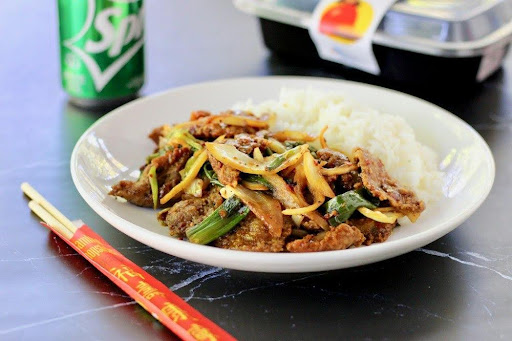Mongolian Beef is a delightful dish that combines tender slices of beef with a lusciously thick sauce, characterized by its sweet, savory, and slightly spicy flavors. This recipe, tailored for home cooks, simplifies the process while maintaining the authentic taste that makes Mongolian Beef a favorite in many restaurants.
Let’s dive into this culinary journey and bring a taste of Mongolia to your kitchen.
Understanding the Ingredients
Before we start cooking, it’s essential to understand the ingredients that make Mongolian Beef so special. The star of the dish is, of course, the beef. Flank steak is commonly used due to its perfect balance of lean meat and flavorful fat. It’s crucial to slice the beef against the grain to ensure it cooks up tender and juicy.
The sauce is another vital component, typically made from a combination of soy sauce, brown sugar, and garlic. This mix creates a harmony of flavors – the soy sauce brings saltiness and umami, the brown sugar adds sweetness and helps the sauce caramelize, and the garlic adds a punch of flavor that’s essential in many Asian dishes.
Other ingredients include green onions and ginger. The green onions add a mild, slightly sweet flavor, and the ginger provides a warm, spicy note that cuts through the richness of the sauce.
Preparing the Beef
The preparation of Mongolian beef begins by cutting the flank steak into thin strips. Remember, slicing against the grain of the meat is critical to ensuring that your beef is tender rather than chewy.
Once the beef is sliced, it’s time to tenderize it. This can be done simply by marinating the beef in a mixture of cornstarch and water. The cornstarch acts as a tenderizer and also helps thicken the sauce later on. Let the beef marinate for about 30 minutes; this not only tenderizes the meat but also allows it to absorb the flavors of the marinade.
Crafting the Perfect Sauce
The sauce is what truly brings Mongolian Beef to life. In a bowl, combine soy sauce, brown sugar, and minced garlic. The ratio of these ingredients can be adjusted depending on your taste preference. If you like your Mongolian Beef sweeter, add more brown sugar. For a more savory flavor, increase the soy sauce.
Another component to consider is the level of spiciness. Traditional Mongolian Beef has a slight kick to it, usually provided by red pepper flakes. If you prefer a milder version, you can reduce the amount of pepper flakes or omit them altogether.
Once your sauce ingredients are combined, set the mixture aside. This sauce will be added to the beef later in the cooking process.
Cooking the Beef to Perfection
Cooking the beef properly is essential for achieving the right texture and flavor. Start by heating a large skillet or wok over high heat. Add a couple of tablespoons of oil – vegetable or canola oil works well. Once the oil is hot, add the beef strips in batches. It’s important not to overcrowd the pan; this ensures that each piece of beef gets nicely browned.
Cook the beef until it’s just browned, and then remove it from the pan. Don’t worry about cooking it through at this stage – the beef will continue to cook when it’s added back to the sauce.
Bringing It All Together
Now, it’s time to bring all the elements of the dish together. In the same pan used for the beef, add a bit more oil and sauté the minced ginger until it becomes fragrant. This should take about a minute. Then, pour in the sauce mixture and let it come to a simmer. The sauce will begin to thicken due to the cornstarch in the beef marinade.
Once the sauce has thickened, add the cooked beef back into the pan. Toss the beef in the sauce until it’s well-coated and heated through. This should take about 2-3 minutes. Finally, add the green onions and stir for another minute, and your Mongolian Beef is ready to serve.
Serve your Mongolian Beef over a bed of steamed rice or noodles for a complete meal. This dish is not only delicious but also visually appealing, with its glossy sauce and vibrant green onions.
The Art of Plating
Finally, the presentation of Mongolian Beef can elevate the entire dining experience. Use a wide plate or bowl to give the dish space. Place the rice or noodles first, then top them with the Mongolian Beef, ensuring the sauce is drizzled attractively.
Add your garnishes strategically for color and texture. A well-presented plate not only enhances the appeal of the dish but also makes the dining experience more enjoyable.
In conclusion, with these variations and serving suggestions, your Mongolian Beef dish can transform into an exciting culinary adventure. Experimenting with different ingredients and presentation styles can turn this simple recipe into a gourmet experience tailored to your personal preferences and suitable for any dining occasion.
Conclusion
Mongolian Beef is not only a simple and flavorful dish but also a testament to the beauty of Asian cuisine. Its charm lies in the perfect blend of tender beef and a rich, savory sauce. By following this straightforward recipe, you’ll find that achieving a restaurant-quality taste in your own kitchen is entirely within reach.
The secret to its perfection is in the careful tenderizing of the beef, meticulously balancing the sweet and savory elements in the sauce, and ensuring the beef is cooked to just the right degree of succulence.
This dish is more than just a meal; it’s a culinary experience that brings a touch of exotic flair to your dining table. Ideal for both family dinners and special occasions, this super-easy Mongolian Beef recipe promises to be a hit, winning over the hearts and taste buds of your guests with its delightful combination of flavors and textures.










